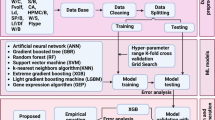Abstract
In the present paper, two models based on artificial neural networks and genetic programming for predicting split tensile strength and percentage of water absorption of concretes containing Al2O3 nanoparticles have been developed at different ages of curing. For purpose of building these models, training and testing using experimental results for 144 specimens produced with 16 different mixture proportions were conducted. The data used in the multilayer feed-forward neural networks models and input variables of genetic programming models are arranged in a format of eight input parameters that cover the cement content, nanoparticle content, aggregate type, water content, the amount of superplasticizer, the type of curing medium, Age of curing and number of testing try. According to these input parameters, in the neural networks and genetic programming models, the split tensile strength and percentage of water absorption values of concretes containing Al2O3 nanoparticles were predicted. The training and testing results in the neural network and genetic programming models have shown that every two models have strong potential for predicting the split tensile strength and percentage of water absorption values of concretes containing Al2O3 nanoparticles. It has been found that NN and GEP models will be valid within the ranges of variables. In neural networks model, as the training and testing ended when minimum error norm of network gained, the best results were obtained, and in genetic programming model, when 4 gens was selected to construct the model, the best results were acquired. Although neural network have predicted better results, genetic programming is able to predict reasonable values with a simpler method rather than neural network.

















Similar content being viewed by others
Change history
06 January 2021
A Correction to this paper has been published: https://doi.org/10.1007/s00521-020-05576-1
References
Ye G, Lura P, van Breugel K (2006) Modelling of water permeability in cementitious materials. Mater Struct 39:877–885
Hong-Guang N, Ji-Zong W (2000) Prediction of compressive strength of concrete by neural networks. Cement Concr Res 30(8):1245–1250
Pala M, Ozbay O, Oztas A, Yuce MI (2005) Appraisal of long-term effects of fly ash and silica fume on compressive strength of concrete by neural networks. Construct Build Mater 21(2):384–394
Akkurt S, Tayfur G, Can S (2004) Fuzzy logic model for prediction of cement compressive strength. Cement Concr Res 34(8):1429–1433
Baykasog˘lu A, Dereli T, Tanıs_ S. Prediction of cement strength using soft computing techniques. Cement Concr Res 2004;34(11):2083–90
Akkurt S, Ozdemir S, Tayfur G, Akyol B (2003) The use of GA-ANNs in the modelling of compressive strength of cement mortar. Cement Concr Res 33(7):973–979
Cevik A, Sonebi M (2009) Genetic programming based formulation for fresh and hardened properties of self-compacting concrete containing pulverised fuel ash. Constr Build Mater 23(7):2614–2622
Cevik A, Sonebi M (2008) Modelling the performance of self-compacting SIFCON of cement slurries using genetic programming technique. Comput Concr 5(5):475–491
ASTM C150 (2001) Standard specification for Portland cement, annual book of ASTM standards, ASTM, Philadelphia
ASTM C39 (2001) Standard test method for compressive strength of cylindrical concrete specimens, ASTM, Philadelphia
ASTM C642 (2001) Standard test method for density, absorption, and voids in hardened concrete, ASTM, Philadelphia
Shih JY, Chang TP, Hsiao TC (2006) Effect of nanosilica on characterization of Portland cement composite. Cement Concr Res 36:697–706
Li H, Zhang M, Ou J (2007) Flexural fatigue performance of concrete containing nanoparticles for pavement. Int J Fatigue 29:1292–1301
Ye Q (2001) The study and development of the nano-composite cement structure materials. New building materials (1):4–6
Mukherjee A, Biswas SN (1997) Artificial neural networks in prediction of mechanical behavior of concrete at high temperature. Nucl Eng Design 178(1):1–11
Ince R (2004) Prediction of fracture parameters of concrete by artificial neural networks. Eng Fract Mech 71(15):2143–2159
McCulloch WS, Pitts W (1943) A logical calculus of the ideas immanent in neural nets. Bull Math Biophys 5:115–137
Rosenblatt F (1962) Principles of neuro dynamics: perceptrons and the theory of brain mechanisms. Spartan Books, Washington, DC
Rumelhart DE, Hinton GE, William RJ (1986) Learning internal representation by error propagation. In: Rumelhart DE, McClelland JL (eds) Proceeding parallel distributed processing foundation, vol 1. MIT Press, Cambridge
Liu SW, Huang JH, Sung JC, Lee CC (2002) Detection of cracks using neural networks and computational mechanics. Comput Meth Appl Mech Eng 191(25–26):2831–2845
Anderson JA (1983) Cognitive and psychological computation with neural models. IEEE Trans Syst Man Cybernetics V.SMC 13(5):799–814
Hopfield JJ (1982) Neural networks and physical systems with emergent collective computational abilities. Proc Natl Acad Sci 79:2554–2558
Suratgar AA, Tavakoli MB, Hoseinabadi A (2005) Modified Levenberg–Marquardt method for neural networks training. World Acad Sci Eng Technol 6:46–48
Koza JR (1992) Genetic programming: on the programming of computers by means of natural selection. MIT Press, Cambridge
Ferreira C (2001) Gene expression programming in problem solving. In: Invited tutorial of the 6th online world conference on soft computing in industrial applications
Ferreira C (2001) Gene expression programming: a new adaptive algorithm for solving problems. Complex Syst 13(2):87–129
Ferreira C (2002) Gene expression programming: mathematical modeling by an artificial intelligence
Ferreira C (2001) Gene expression programming in problem solving. In: 6th Online world conference on soft computing in industrial applications (invited tutorial)
Çiftci ON, Fadıloğlu S, Goğuş F, Guven A (2009) Genetic programming approach to predict a model acidolysis system. Eng Appl Artif Intell 22(4–5):759–766
Topcu IB, Sarıdemir M (2008) Prediction of compressive strength of concrete containing fly ash using artificial neural network and fuzzy logic. Comput Mater Sci 41(3):305–311
Author information
Authors and Affiliations
Corresponding author
About this article
Cite this article
Nazari, A., Riahi, S. RETRACTED ARTICLE: Computer-aided prediction of the Al2O3 nanoparticles’ effects on tensile strength and percentage of water absorption of concrete specimens. Neural Comput & Applic 21, 1651–1667 (2012). https://doi.org/10.1007/s00521-011-0700-9
Received:
Accepted:
Published:
Issue Date:
DOI: https://doi.org/10.1007/s00521-011-0700-9




